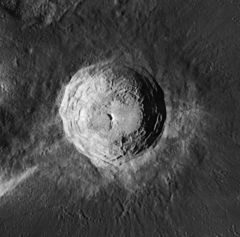Aristarchus crater

Lunar Orbiter 4 image
|
|
| Coordinates | 23°42′N 47°24′W / 23.7°N 47.4°WCoordinates: 23°42′N 47°24′W / 23.7°N 47.4°W |
|---|---|
| Diameter | 40 km (25 mi) |
| Depth | 3.7 km (2.3 mi) |
| Colongitude | 48° at sunrise |
| Eponym | Aristarchus of Samos |
Aristarchus, named after the Greek astronomer Aristarchus of Samos, is a prominent lunar impact crater that lies in the northwest part of the Moon's near side. It is considered the brightest of the large formations on the lunar surface, with an albedo nearly double that of most lunar features. The feature is bright enough to be visible to the naked eye, and displays unusually bright features when viewed through a large telescope. It is also readily identified when most of the lunar surface is illuminated by earthshine. The crater is larger than the Grand Canyon.
The crater is located at the southeastern edge of the Aristarchus plateau, an elevated area that contains a number of volcanic features, such as sinuous rilles. This area is also noted for the large number of reported transient lunar phenomena, as well as recent emissions of radon gas as measured by the Lunar Prospector spacecraft.
Aristarchus is located on an elevated rocky rise, known as the Aristarchus Plateau, in the midst of the Oceanus Procellarum, a large expanse of lunar mare. This is a tilted crustal block, about 200 km across, that rises to a maximum elevation of 2 km above the mare in the southeastern section. Aristarchus is just to the east of the crater Herodotus and the Vallis Schröteri, and south of a system of narrow sinuous rilles named Rimae Aristarchus.
Aristarchus is bright because it is a young formation, approximately 450 million years old, and the solar wind has not yet had time to darken the excavated material by the process of space weathering. The impact occurred following the creation of the ray crater Copernicus, but before the appearance of Tycho. Due to its prominent rays, Aristarchus is mapped as part of the Copernican System.
...
Wikipedia
